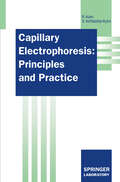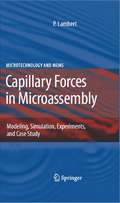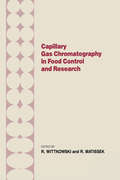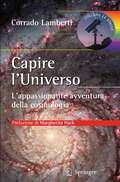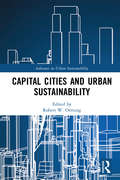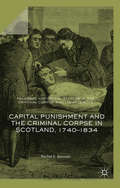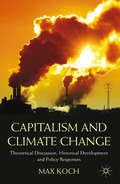- Table View
- List View
Capillary Electrophoresis - Mass Spectrometry (CE-MS): Principles and Applications
by Gerhardus de JongThis monograph offers the reader a complete overview on both principles and applications of CE-MS. Starting with an introductory chapter on detection in CE, also related and more specialized techniques such as electrophoretic and chromatographic preconcentration are discussed. A special emphasis is put on CE-MS interfaces, which are described in detail. In a separate chapter, attention is paid to sheath-liquid interfacing. The developments and possibilities of microchip CE-MS are also described. Applications to all relevant areas are discussed in distinct chapters, each written by experts in the respective fields. Besides applications in pharmaceutical analysis and bioanalysis, recent implementations in food science, forensic analysis, analysis of intact proteins, metabolomics and proteomics are highlighted. MS is a perfectly appropriate detection system for CE, as efficient separation is coupled to sensitive and selection detection. Moreover, MS can provide structure information on the separated compounds. CE-MS has now been developed into a strong hyphenated system complementary to LC-MS. This monograph is an unique source of knowledge for everyone dealing with and interested in CE-MS.
Capillary Electrophoresis - Mass Spectrometry for Proteomics and Metabolomics: Principles and Applications
by Rawi RamautarCapillary Electrophoresis—Mass Spectrometry for Proteomics and Metabolomics A powerful and essential resource for researchers with an interest in CE-MS In Capillary Electrophoresis—Mass Spectrometry for Proteomics and Metabolomics: Principles and Applications, a team of distinguished researchers delivers a comprehensive overview of bioanalytical capillary electrophoresis coupled to mass spectrometry (CE-MS). The book explains foundational principles, technology as well the strategies and techniques used in data analysis for metabolic and proteomic studies. It also provides a global overview of recent developments and advances for improving CE-MS sensitivity and reproducibility. An essential handbook for everyone performing metabolomic and proteomic analysis, the information provided here will assist researchers in tapping into the full potential of this technique to answer biological and clinical questions. Readers will also find: A thorough introduction to the principles of capillary electrophoresis, including its fundamentals, CE separation modes, capillary coatings, and the fundamentals of mass spectrometry In-depth examinations of technological developments in capillary electrophoresis, including sample preparation, online preconcentration, detection sensitivity, and metabolic coverage Comprehensive discussions of metabolomic studies, including their biomedical and clinical applications Recent advances in proteomics, including top-down and bottom-up approaches Perfect for analytical and clinical chemists, Capillary Electrophoresis—Mass Spectrometry for Proteomics and Metabolomics: Principles and Applications will also earn a place in the libraries of biochemists, molecular biologists, and other molecular life scientists.
Capillary Electrophoresis - Mass Spectrometry for Proteomics and Metabolomics: Principles and Applications
by Rawi Ramautar David D. Y. ChenCapillary Electrophoresis—Mass Spectrometry for Proteomics and Metabolomics A powerful and essential resource for researchers with an interest in CE-MS In Capillary Electrophoresis—Mass Spectrometry for Proteomics and Metabolomics: Principles and Applications, a team of distinguished researchers delivers a comprehensive overview of bioanalytical capillary electrophoresis coupled to mass spectrometry (CE-MS). The book explains foundational principles, technology as well the strategies and techniques used in data analysis for metabolic and proteomic studies. It also provides a global overview of recent developments and advances for improving CE-MS sensitivity and reproducibility. An essential handbook for everyone performing metabolomic and proteomic analysis, the information provided here will assist researchers in tapping into the full potential of this technique to answer biological and clinical questions. Readers will also find: A thorough introduction to the principles of capillary electrophoresis, including its fundamentals, CE separation modes, capillary coatings, and the fundamentals of mass spectrometry In-depth examinations of technological developments in capillary electrophoresis, including sample preparation, online preconcentration, detection sensitivity, and metabolic coverage Comprehensive discussions of metabolomic studies, including their biomedical and clinical applications Recent advances in proteomics, including top-down and bottom-up approaches Perfect for analytical and clinical chemists, Capillary Electrophoresis—Mass Spectrometry for Proteomics and Metabolomics: Principles and Applications will also earn a place in the libraries of biochemists, molecular biologists, and other molecular life scientists.
Capillary Electrophoresis of Biomolecules: Methods and Protocols (Methods in Molecular Biology)
by Nicola Volpi and Francesca MaccariCapillary electrophoresis (CE) is a relatively new separation technique suitable for handling small amounts of sample very important in bioanalytical research and in various clinical, diagnostic, genetic, and forensic applications. In Capillary Electrophoresis of Biomolecules: Methods and Protocols, expert researchers in the field provide key techniques to investigate CE focusing on simple and complex carbohydrates (polysaccharides), aminoacids, peptides and proteins, enzymes, and nucleic acids. Along with practical procedures, reviews discussing CE applications related to bio(macro)molecules are also included. Written in the highly successful Methods in Molecular Biology™ series format, chapters include introductions to their respective topics, lists of the necessary materials and reagents, step-by-step, readily reproducible laboratory protocols, and key tips on troubleshooting and avoiding known pitfalls.Authoritative and practical, Capillary Electrophoresis of Biomolecules: Methods and Protocols provides the reader with the latest break throughs and improvements in CE and CE techniques applied to several classes of bio(macro)molecules.
Capillary Electrophoresis of Carbohydrates (Methods in Molecular Biology #213)
by Pierre Thibault and Susumu HondaCapillary Electrophoresis of Carbohydrates: From Monosaccharides to Complex Polysaccharides
by Nicola VolpiSimple carbohydrates, complex oligosaccharides and polysaccharides all belong to a class of ubiquitous (macro)molecules that exhibit a wide range of biological functions, and the recent advent of enhanced enzymatic, chemical and analytical tools used to study these sugars has inaugurated a genuine explosion in the field of glycomics. Specifically, it has led to a deeper understanding of how specific sugar structures modulate cellular phenotypes, and that breakthrough has led to the discovery of new pharmaceuticals for the treatment of many serious diseases, such as cancer. The subsequent rapid expansion of this research holds high promise for future therapeutic regimens, and capillary electrophoresis (CE) refers to the range of related separation techniques that are integral to this vital research. CE uses narrow-bore fused-silica capillaries to separate a complex array of large and small molecules, and Capillary Electrophoresis of Carbohydrates offers a comprehensive look at the latest breakthroughs and improvements in CE and CE techniques applied to monosaccharides up to complex oligosaccharides and polysaccharides. It begins with an overview of the application of CE and CE- mass spectrometric in the analysis of simple carbohydrates without any previous derivatization step before discussing various detection techniques such as spectrophotometric detection, electrochemical detection and other less common techniques. It then covers in detail an array of related topics and numerous applications. It is an essential text for anyone exploring the myriad possibilities of this rapidly expanding field.
Capillary Electrophoresis of Nucleic Acids (Methods in Molecular Biology #162)
by Keith R. Mitchelson and Jing ChengThe development of PCR, which enables extremely small amounts of DNA to be amplified, led to the rapid development of a multiplicity of a- lytical procedures that permit use of this new resource for the analysis of genetic variation and for the detection of disease-causing mutations. The advent of capillary electrophoresis (CE), with its power to separate and a- lyze very small amounts of DNA, has also stimulated researchers to develop analytical procedures for the CE format. The advantages of CE in terms of speed and reproducibility of analyses are manifold. Furthermore, the high s- sitivity of detection, and the ability to increase sample throughput with par- lel analysis, has led to the creation of a full range of analysis of DNA molecules, from modified DNA adducts and single-strand oligonucleotides through PCR-amplified DNA fragments and whole chromosomes. Capillary Elect- phoresis of Nucleic Acids focuses on analytical protocols that can be used for detection and analysis of mutations and modification, from precise DNA loci through entire genomes of organisms. Important practical considerations for CE, such as the choice of separation media, electrophoresis conditions, and the influence of buffer additives and dyes on DNA mobility, are discussed in several key chapters and within particular applications.
Capillary Electrophoresis of Nucleic Acids (Methods in Molecular Biology #163)
by Keith R. Mitchelson and Jing ChengThe development of PCR, which enables extremely small amounts of DNA to be amplified, led to the rapid development of a multiplicity of a- lytical procedures to utilize this new resource for analysis of genetic variation and for the detection of disease causing mutations. The advent of capillary electrophoresis (CE), with its power to separate and analyze very small amounts of DNA, has also stimulated researchers to develop analytical procedures for the CE format. The advantages of CE in terms of speed and reproducibility of analysis are manifold. Further, the high sensitivity of detection, and the ab- ity to increase sample throughput with parallel analysis, has led to the creation of a full range of analysis of DNA molecules, from modified DNA-adducts and single–strand oligonucleotides through to PCR-amplified DNA fragments and whole chromosomes. Capillary Electrophoresis of Nucleic Acids focuses on such analytical protocols, which can be used for detection and analysis of mutations and modification, from precise DNA loci through to entire genomes of organisms. Important practical considerations for CE, such as the choice of separation media, electrophoresis conditions, and the influence of buffer additives and dyes on DNA mobility, are discussed in several key chapters and within particular applications.
Capillary Electrophoresis of Proteins and Peptides (Methods in Molecular Biology #276)
by Mark A. Strege and Avinash L. LaguThroughout the more than 20 years that have followed the beginnings of capillary electrophoresis (CE), its application to the analysis of proteins and peptides has continued to be reliable, versatile, and productive. Over time, CE has matured to become a superb complement to HLPC, and in many cases has also evolved as an automated and quantitative replacement for conventional slab gel electrophoresis methods such as SDS-PAGE and isoelectric focusing. Within Capillary Electrophoresis of Proteins and Peptides, we have assembled contributions from researchers who are applying state-of-the-art CE for protein and peptide analysis, including topics that we believe are of great potential both in the present and for the future. In comparison to traditional separation methods, CE represents a miniaturized analysis technique (especially in its microchip-based format) that is highly dependent upon the basic fundamentals of effective sample recovery and high sensitivity detection. With these issues in mind, Chapters 1–4 describe recently developed approaches for both capillary coatings and analyte detection via laser-induced fluorescence. Since the discipline of biotechnology has established itself as a primary platform for the application of CE to the analysis of proteins and peptides, Chapters 5–7 demonstrate a variety of examples of the specific techniques that have been applied for the development of biopharmaceuticals and their commercialization. The methods covered here include also the analysis of oligosaccharides from glycoproteins.
Capillary Electrophoresis of Proteins and Peptides: Methods and Protocols (Methods in Molecular Biology #1466)
by Nguyet Thuy Tran and Myriam TavernaThis book provides a comprehensive survey of recent developments and applications of high performance capillary electrophoresis in the field of protein and peptide analysis with a distinct focus on the analysis of intact proteins. With practical detail, the contents cover different modes of capillary electrophoresis (CE) useful for protein and peptide analysis, CZE, CIEF, ACE, CGE, and different types of application such as the quality control of therapeutic proteins and monoclonal antibodies, clinical analyses of chemokines in tissues, qualitative and quantitative analysis of vaccine proteins, and determination of binding constants in complexes involving peptides or proteins. Written for the highly successful Methods in Molecular Biology series, chapters include introductions to their respective topics, lists of the necessary materials and reagents, step-by-step, readily reproducible laboratory protocols, and tips on troubleshooting and avoiding known pitfalls. Authoritative and exhaustive, Capillary Electrophoresis of Proteins and Peptides: Methods and Protocols serves both beginners and experts with a collection of the current and most active topics in this vital field of study.
Capillary Electrophoresis: Principles and Practice (Springer Lab Manuals)
by Reinhard Kuhn Sabrina Hoffstetter-KuhnCapillary electrophoresis (CE) is a brand-new analytical me- thod with the capability of solving many analytical separa- tion problems very fast and economically. This method gives new information about the investigated substances which can- not easily be obtained by other means. CE has become an established method only recently, but will be implemented in almost every analytical laboratory in industry, service units and academia in the near future. The most important fields of CE application are pharmaceutical and biochemical research and quality control. The authors have exhaustive practical experience in the application of CE methods in the pharmaceutical industry and provide the reader with a comprehensive treatment of this method. The main focus is on how to solve problems when applying CE in the laboratory. Physico-chemical theory is only dealt with in depth when necessary to understand the underlying separation mechanisms in order to solve your problems at the analytical bench. An addendum includes tables on the preparation of buffers and recommended further reading.
Capillary Forces in Microassembly: Modeling, Simulation, Experiments, and Case Study (Microtechnology and MEMS)
by Pierre LambertCapillary Forces in Microassembly discusses the use of capillary forces as a gripping principle in microscale assembly. Clearly written and well-organized, this text brings together physical concepts at the microscale with practical applications in micromanipulation. Throughout this work, the reader will find a review of the existing gripping principles, elements to model capillary forces as well as descriptions of the simulation and experimental test bench developed to study the design parameters. Using well-known concepts from surface science (such as surface tension, capillary effects, wettability, and contact angles) as inputs to mechanical models, the amount of effort required to handle micro-components is then predicted. Researchers and engineers involved in micromanipulation and precision assembly will find this a highly useful reference for microassembly system design and analysis.
Capillary Gas Adsorption Chromatography (Chromatographic Methods)
by V. G. Berezkin Jaap de ZeeuwAn e-book on the use of capillary gas adsorption columns in the lab and within a range of fields With capillary gas adsorption columns commonly in use in laboratories today, this book was written to present a consistent treatment of gas-solid capillary chromatography. The technique utilizes an open-tubular column with a solid sorbent layer inside. Capillary Gas Adsorption Chromatography discusses the importance of the columns in analysing gases and light volatile compounds in chemistry, chemical engineering, petrochemistry, medicine, pharmacy, food science, environmental pollution control, and other fields. Chromatograms in the book illustrate the analytical potential and the role of capillary gas-solid columns in gas chromatography.
Capillary Gas Chromotography in Food Control and Research
by R. WittkowskiThis book offers a comprehensive survey on the possibilities, applications, and new developments of capillary gas chromatography for the complete range of examinations of food and raw material. It is intended for food scientists/chemists, food technologists, and nutritionists.
Capillary Gas Chromotography in Food Control and Research
by R. WittkowskiThis book offers a comprehensive survey on the possibilities, applications, and new developments of capillary gas chromatography for the complete range of examinations of food and raw material. It is intended for food scientists/chemists, food technologists, and nutritionists.
Capillary Surfaces: Shape — Stability — Dynamics, in Particular Under Weightlessness (Springer Tracts in Modern Physics #178)
by Dieter W. LangbeinFeaturing a foreword by the astronaut Ulf Merbold, this book is devoted to interfaces between two fluids, that is, between a liquid and a gas or between two liquids. It is the first review on the subject, providing an up-to-date overview.
Capire l’Universo: L'appassionante avventura della cosmologia (Le Stelle)
by Corrado LambertiSi ripercorre la storia della cosmologia moderna, dal XVIII secolo fino alle più recenti scoperte (l'opera è aggiornata fino alla fine 2010). La cosmologia fa uso di concetti complessi, che vengono spesso fraintesi, o che non vengono compresi del tutto, da chi non è specialista del campo. Lo scopo del volume è di trattare esaustivamente tali concetti, entrando nel dettaglio per far cogliere intuitivamente il loro significato autentico anche ai non addetti: a questo scopo, si fa uso di metafore calzanti, di analogie newtoniane, di trattazioni quantitative che richiedono solo le conoscenze di fisica e di matematica di uno studente di scuola media superiore. Vengono discusse le idee più importanti e controverse che sono attualmente al centro del dibattito cosmologico, come la materia oscura e l'energia oscura. Vengono sviluppati i concetti di base della Relatività Generale e del Modello Standard delle particelle elementari.
Capital Cities and Urban Sustainability (Advances in Urban Sustainability)
by Robert W. OrttungCapital Cities and Urban Sustainability examines how capital cities use their unique hub resources to develop and disseminate innovative policy solutions to promote sustainability. Cities are taking a leading role in defining a sustainable future at a time when national, state, and regional governments in several countries do not provide sufficient leadership. Capital cities stand out among cities as likely leading drivers in the effort to empower sustainable innovation as they provide a hub for connecting a variety of key constituencies. While acknowledging the successes capital cities have achieved, the international, multi-disciplinary contributors to this work discuss how there is room to do more and improve. The promotion of specific sustainability policies in crucial areas such as clean water provision, high tech innovation, public procurement contracting, and improving flood control in capital cities is examined through various global case studies. The examples range from relatively rich capital cities, such as Copenhagen, where the well-financed hub would be expected to succeed in generating sustainable policies, to poorer cities such as Phnom Penh, where such an optimistic outcome can seem less likely.
Capital Cities and Urban Sustainability (Advances in Urban Sustainability)
by Robert W. OrttungCapital Cities and Urban Sustainability examines how capital cities use their unique hub resources to develop and disseminate innovative policy solutions to promote sustainability. Cities are taking a leading role in defining a sustainable future at a time when national, state, and regional governments in several countries do not provide sufficient leadership. Capital cities stand out among cities as likely leading drivers in the effort to empower sustainable innovation as they provide a hub for connecting a variety of key constituencies. While acknowledging the successes capital cities have achieved, the international, multi-disciplinary contributors to this work discuss how there is room to do more and improve. The promotion of specific sustainability policies in crucial areas such as clean water provision, high tech innovation, public procurement contracting, and improving flood control in capital cities is examined through various global case studies. The examples range from relatively rich capital cities, such as Copenhagen, where the well-financed hub would be expected to succeed in generating sustainable policies, to poorer cities such as Phnom Penh, where such an optimistic outcome can seem less likely.
Capital Punishment and the Criminal Corpse in Scotland, 1740–1834
by Rachel E. BennettThis book is open access under a CC BY 4.0 license.This book provides the most in-depth study of capital punishment in Scotland between the mid-eighteenth and early nineteenth century to date. Based upon an extensive gathering and analysis of previously untapped resources, it takes the reader on a journey from the courtrooms of Scotland to the theatre of the gallows. It introduces them to several of the malefactors who faced the hangman’s noose and explores the traditional hallmarks of the spectacle of the scaffold. It demonstrates that the period between 1740 and 1834 was one of discussion, debate and fundamental change in the use of the death sentence and how it was staged in practice. In addition, the study provides an innovative investigation of the post-mortem punishment of the criminal corpse. It offers the reader an insight into the scene at the foot of the gibbets from which criminal bodies were displayed and around the dissection tables of Scotland’s main universities where criminal bodies were used as cadavers for anatomical demonstration. In doing so it reveals an intermediate stage in the long-term disappearance of public bodily punishment.
Capital Punishment and the Criminal Corpse in Scotland, 1740–1834 (PDF)
by Rachel E. BennettThis book is open access under a CC BY 4.0 license.This book provides the most in-depth study of capital punishment in Scotland between the mid-eighteenth and early nineteenth century to date. Based upon an extensive gathering and analysis of previously untapped resources, it takes the reader on a journey from the courtrooms of Scotland to the theatre of the gallows. It introduces them to several of the malefactors who faced the hangman’s noose and explores the traditional hallmarks of the spectacle of the scaffold. It demonstrates that the period between 1740 and 1834 was one of discussion, debate and fundamental change in the use of the death sentence and how it was staged in practice. In addition, the study provides an innovative investigation of the post-mortem punishment of the criminal corpse. It offers the reader an insight into the scene at the foot of the gibbets from which criminal bodies were displayed and around the dissection tables of Scotland’s main universities where criminal bodies were used as cadavers for anatomical demonstration. In doing so it reveals an intermediate stage in the long-term disappearance of public bodily punishment.
Capitalism and Climate Change: Theoretical Discussion, Historical Development and Policy Responses
by Max KochThis book discusses climate change as a social issue, examining the incompatibility of capitalist development and Earth's physical limits and how these have been regulated in different ways. It addresses the links between modes of consumption, energy regimes and climate change during Fordism and finance-driven capitalism.
Capitalism and Conservation: Conservation, Capitalism And The Future Of Protected Areas (Antipode Book Series #45)
by Dan Brockington Rosaleen DuffyThrough a series of case studies from around the world, Capitalism and Conservation presents a critique of conservation’s role as a central driver of global capitalism. Features innovative new research on case studies on the connections between capitalism and conservation drawn from all over the world Examines some of our most popular leisure pursuits and consumption habits to uncover the ways they drive and deepen global capitalism Reveals the increase in intensity and variety of forms of capitalist conservation throughout the world
Capitalism and Conservation (Antipode Book Series #44)
by Dan Brockington Rosaleen DuffyThrough a series of case studies from around the world, Capitalism and Conservation presents a critique of conservation’s role as a central driver of global capitalism. Features innovative new research on case studies on the connections between capitalism and conservation drawn from all over the world Examines some of our most popular leisure pursuits and consumption habits to uncover the ways they drive and deepen global capitalism Reveals the increase in intensity and variety of forms of capitalist conservation throughout the world
Capitalism and Environmental Collapse
by Luiz MarquesThis book intends to be an alert to the fact that the curve measuring environmental costs against the economic benefits of capitalism has irreversibly entered into a negative phase. The prospect of an environmental collapse has been evidenced by the sciences and the humanities since the 1960s. Today, it imposes its urgency. This collapse differs from past civilizations in that it is neither local nor just civilizational. It is global and occurs at the broadest level of the biosphere, accelerated by the convergence of different socio-environmental crises, such as:Earth energy imbalance, climate change and global warmingSea-level riseDecrease and degradation of forestsCollapse of terrestrial and aquatic biodiversityFloods, droughts, wildfires, and extreme weather events Degradation of soils and water resourcesIncrease in pollution caused by fossil fuels and coal Increase in waste production and industrial intoxicationThe book is divided in two parts. In the first part it presents a comprehensive review of scientific data to show the already visible effects of each of the different environmental crises and its consequences to human life on Earth. In the second part, Luiz Marques critically discusses what he calls the three concentric illusions that prevent us from realizing the gravity of the current socio-environmental crises: the illusion of a sustainable capitalism, the illusion that economic growth is still capable of providing more well-being and the anthropocentric illusion. Finally, Marques argues that "fitting" back into the biosphere will only be possible if we dismantle the expansive socioeconomic gear that has shaped our societies since the 16th century by moving from a Social Contract to a Natural Contract, which takes into account the whole biosphere. According to him, the future society will be post-capitalist or it will not be a complex society, and even perhaps, we must fear, no society at all.









